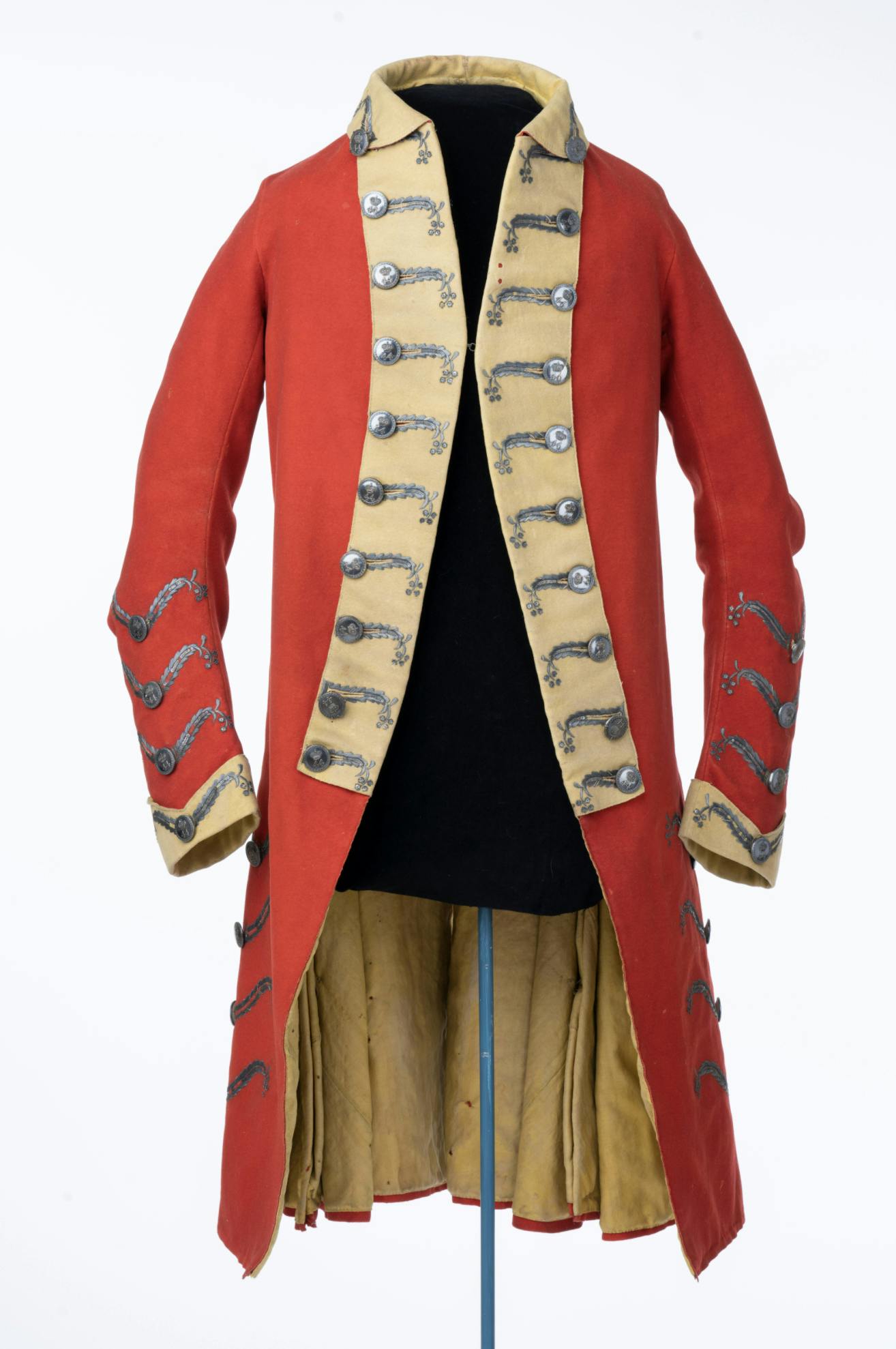
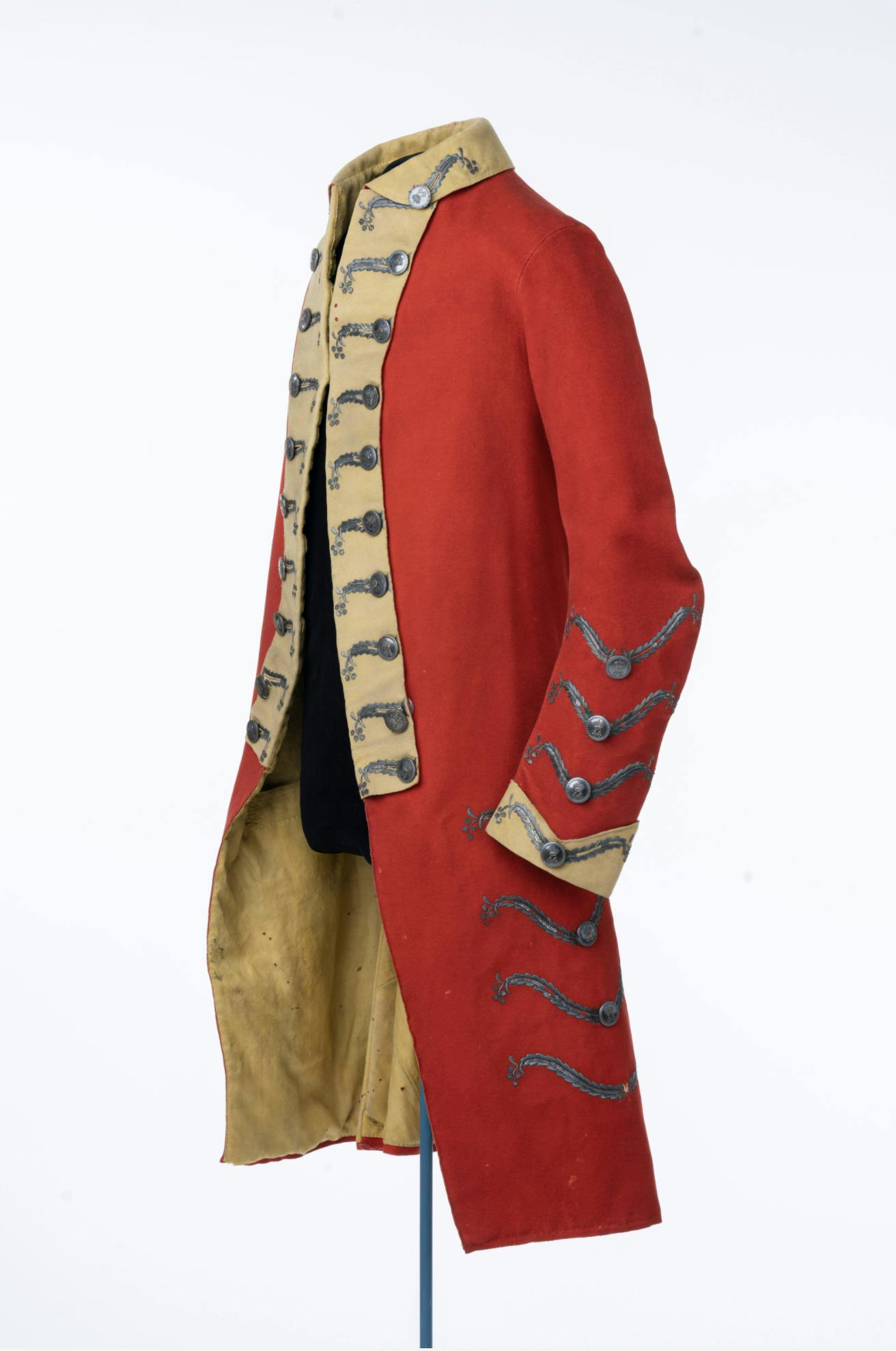
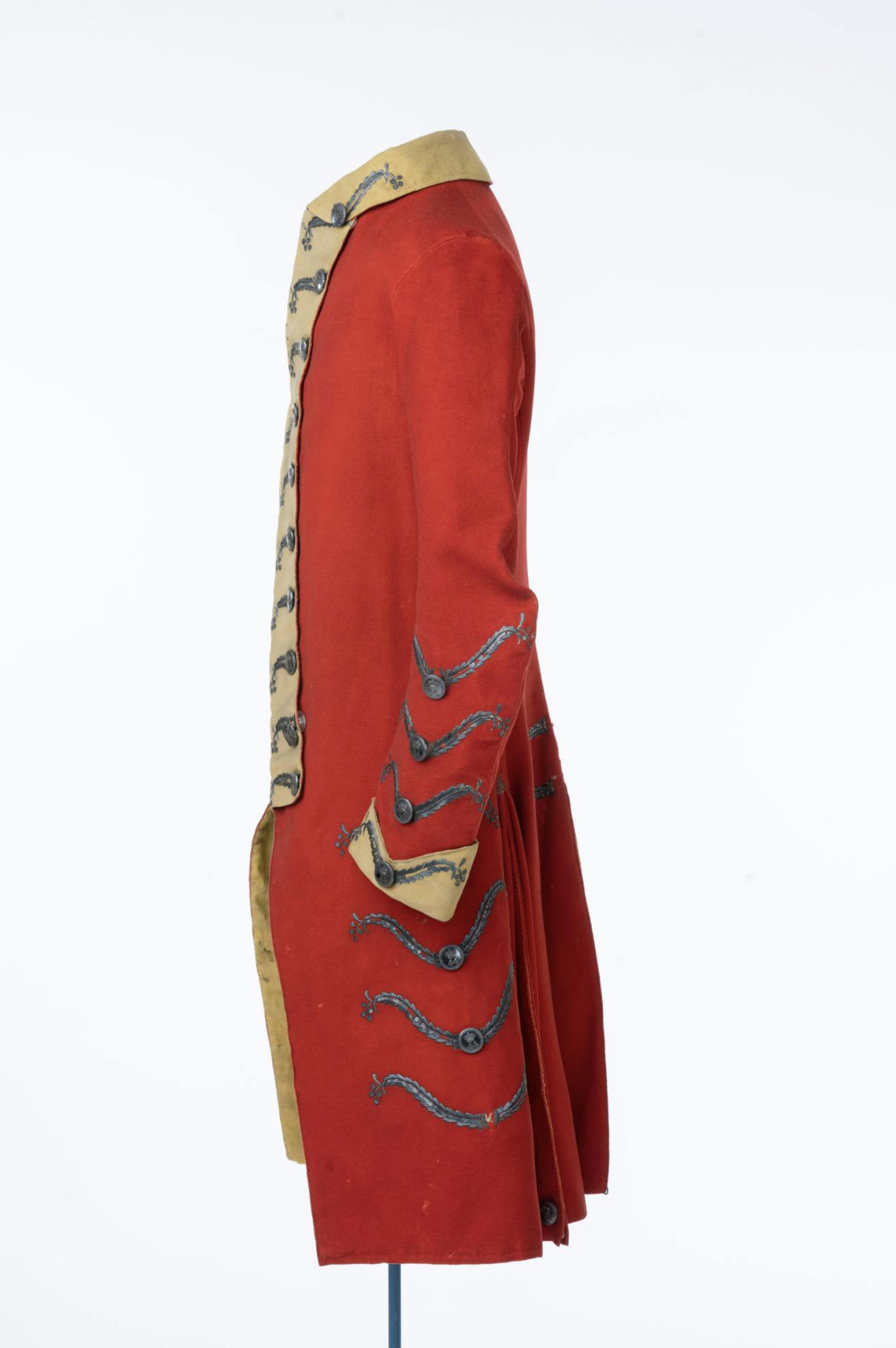
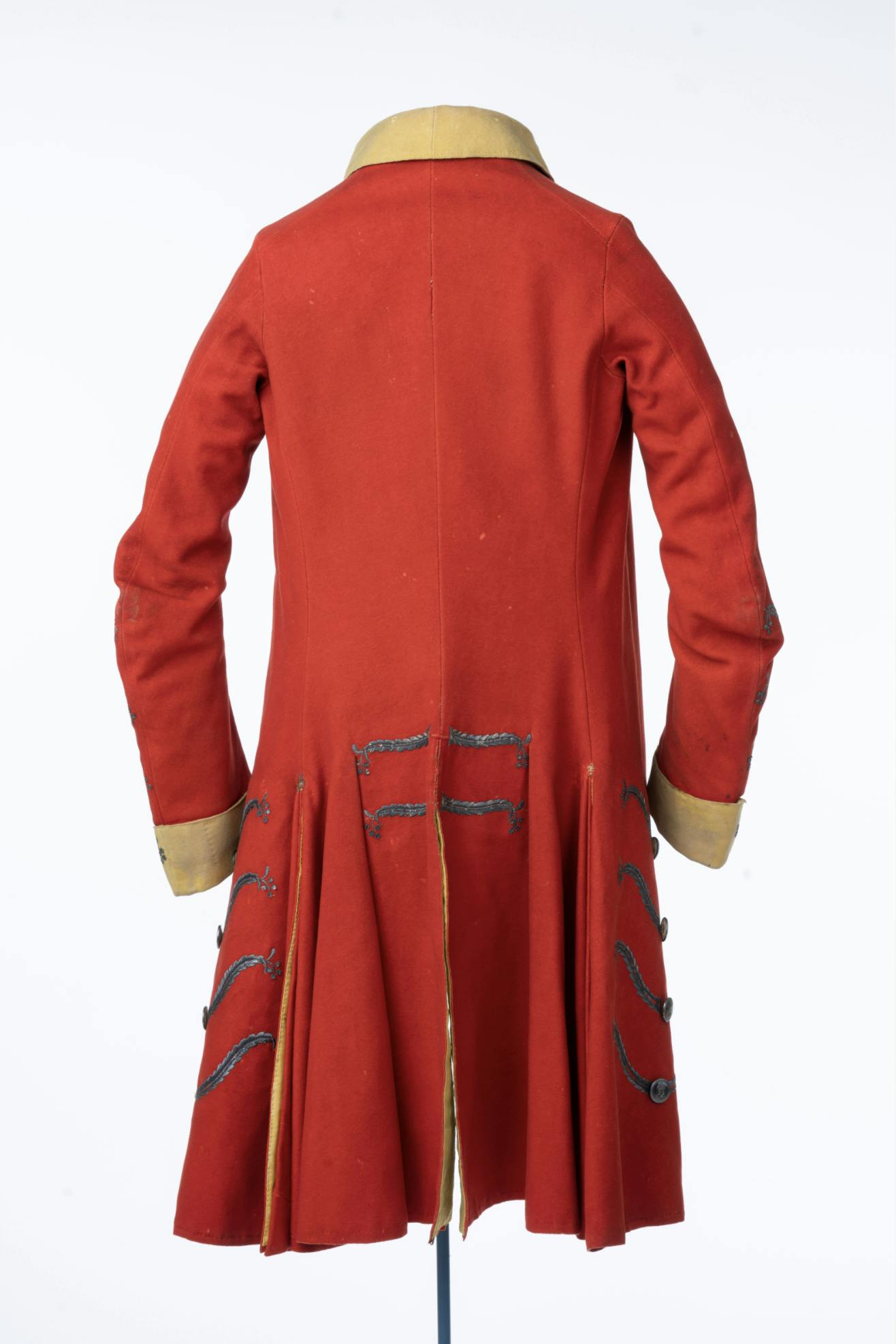
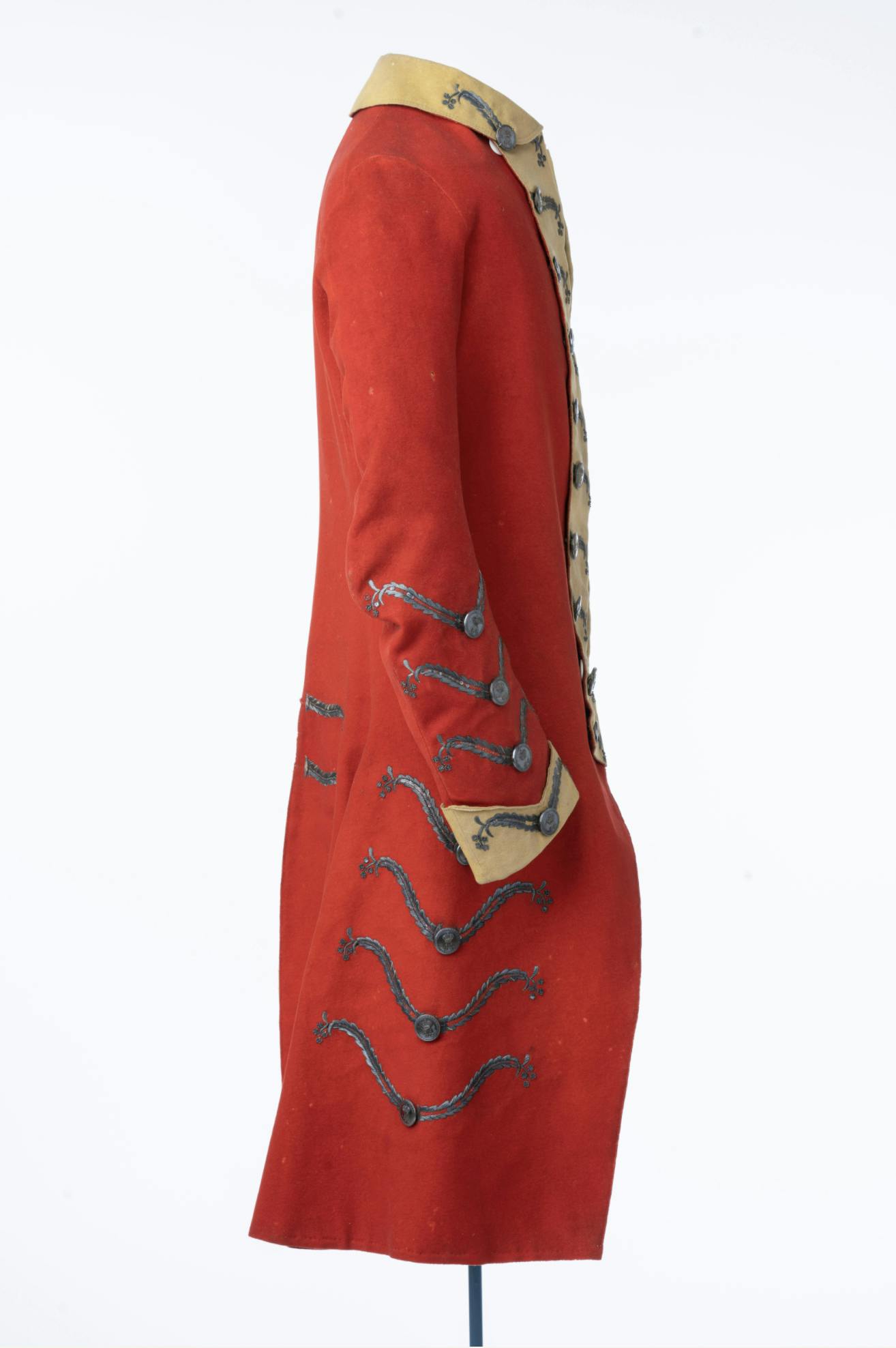
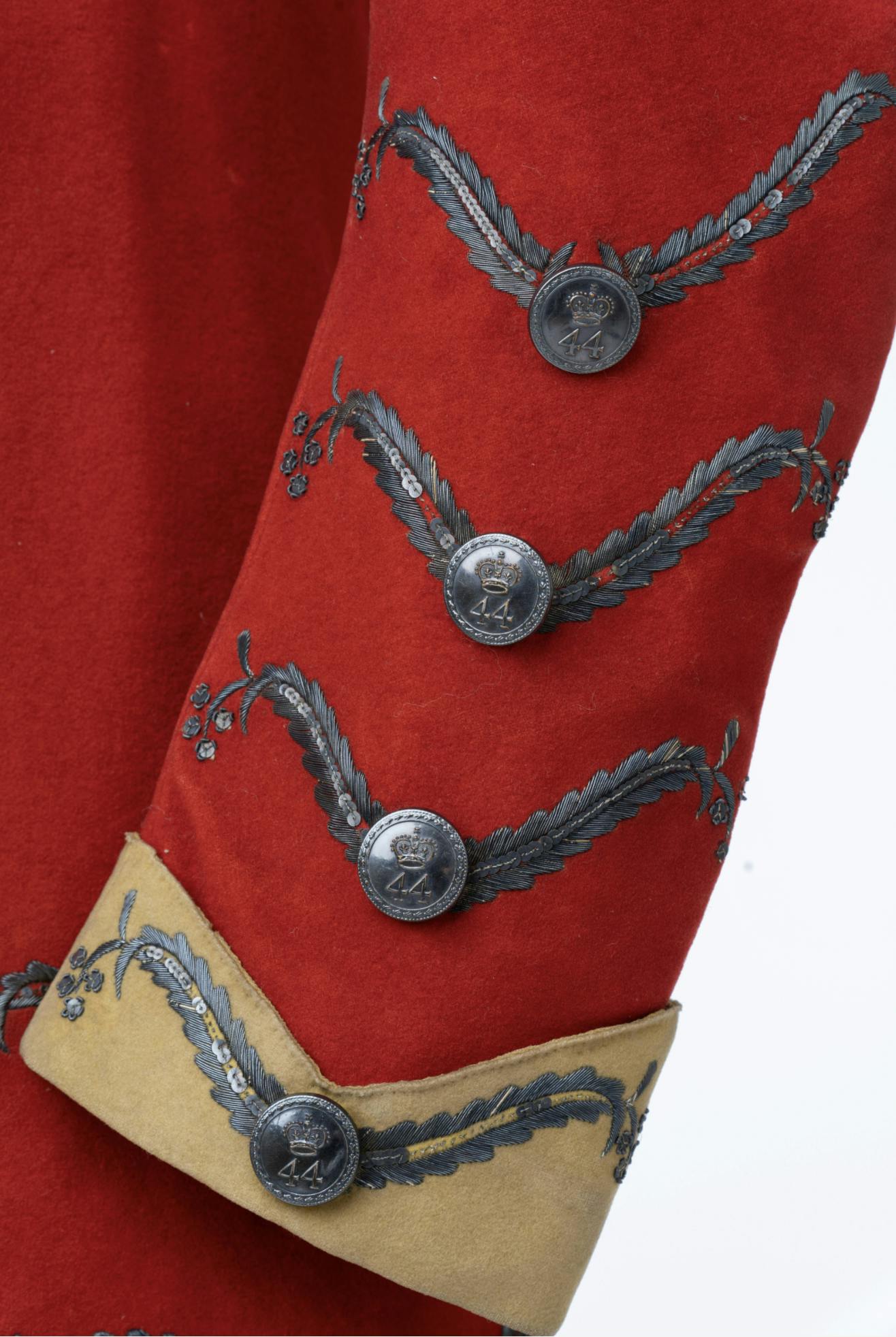
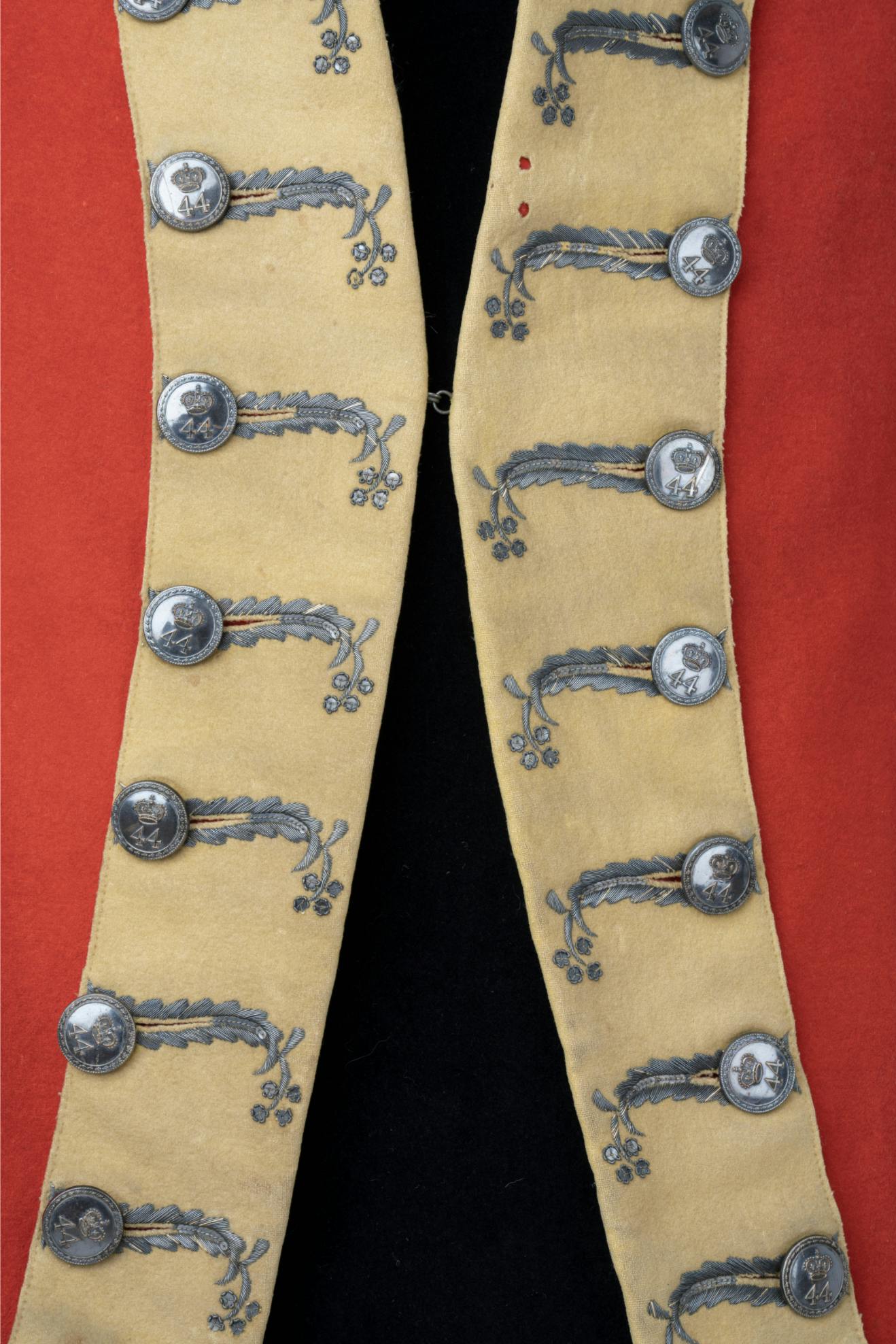
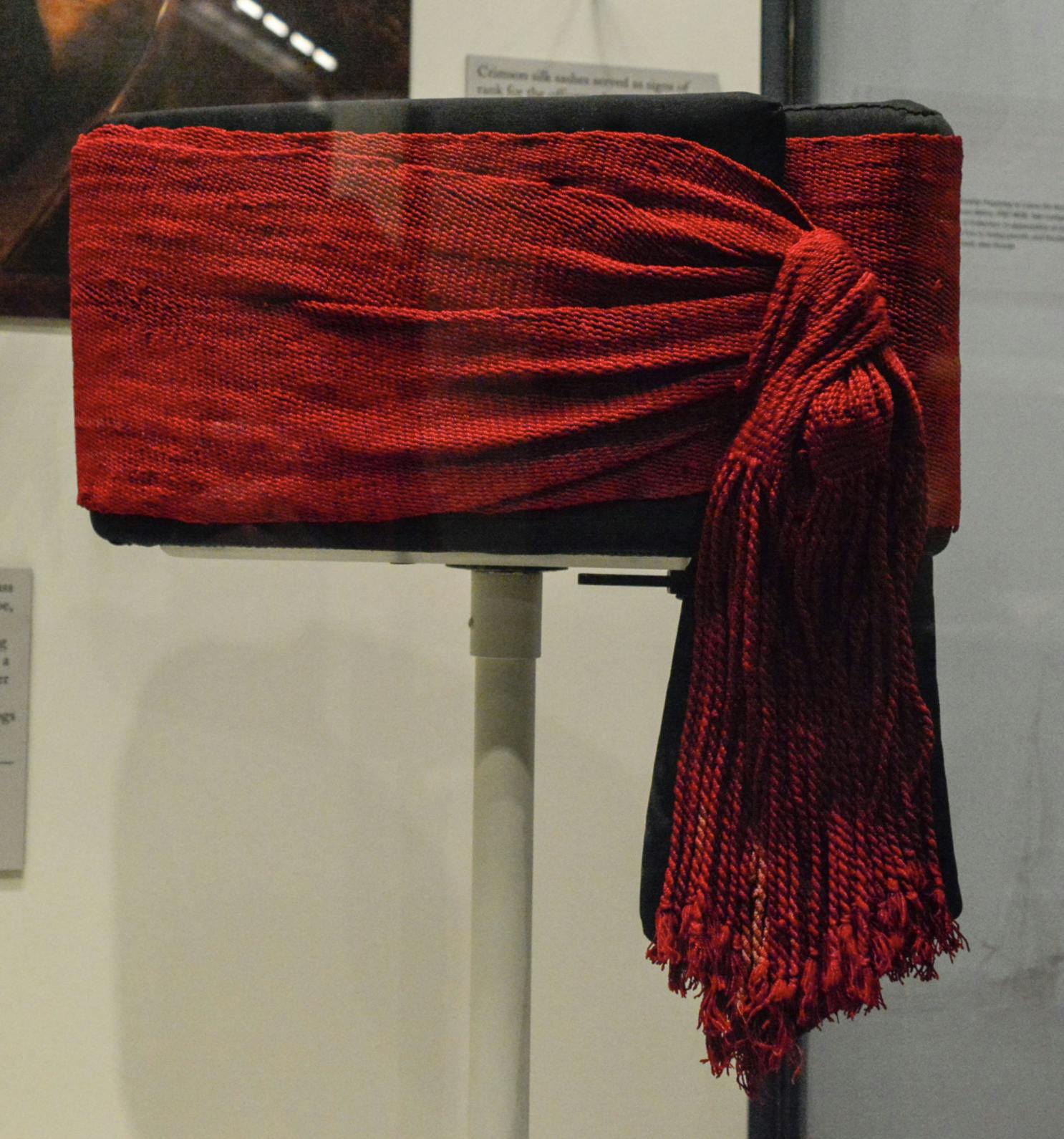
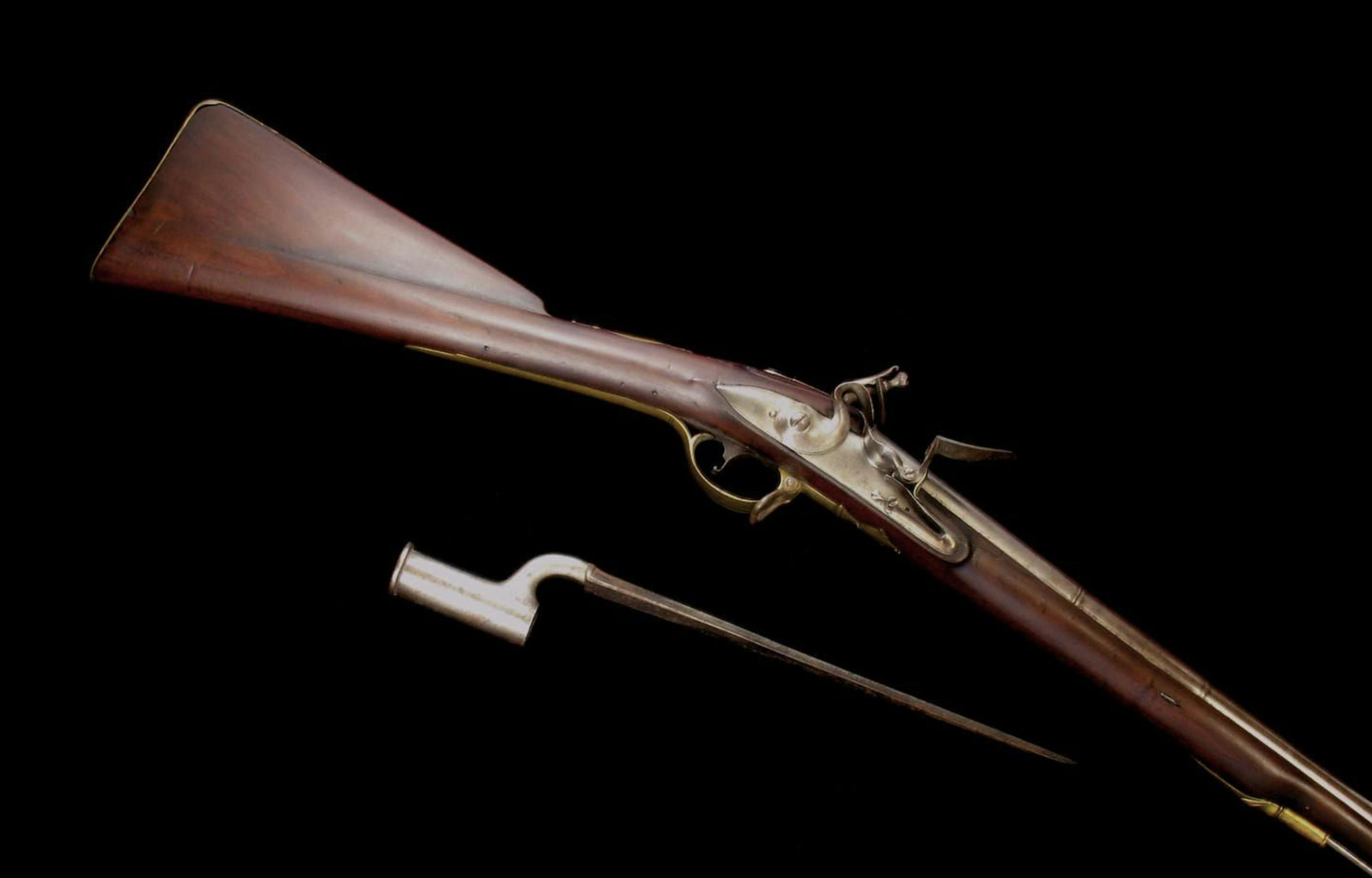
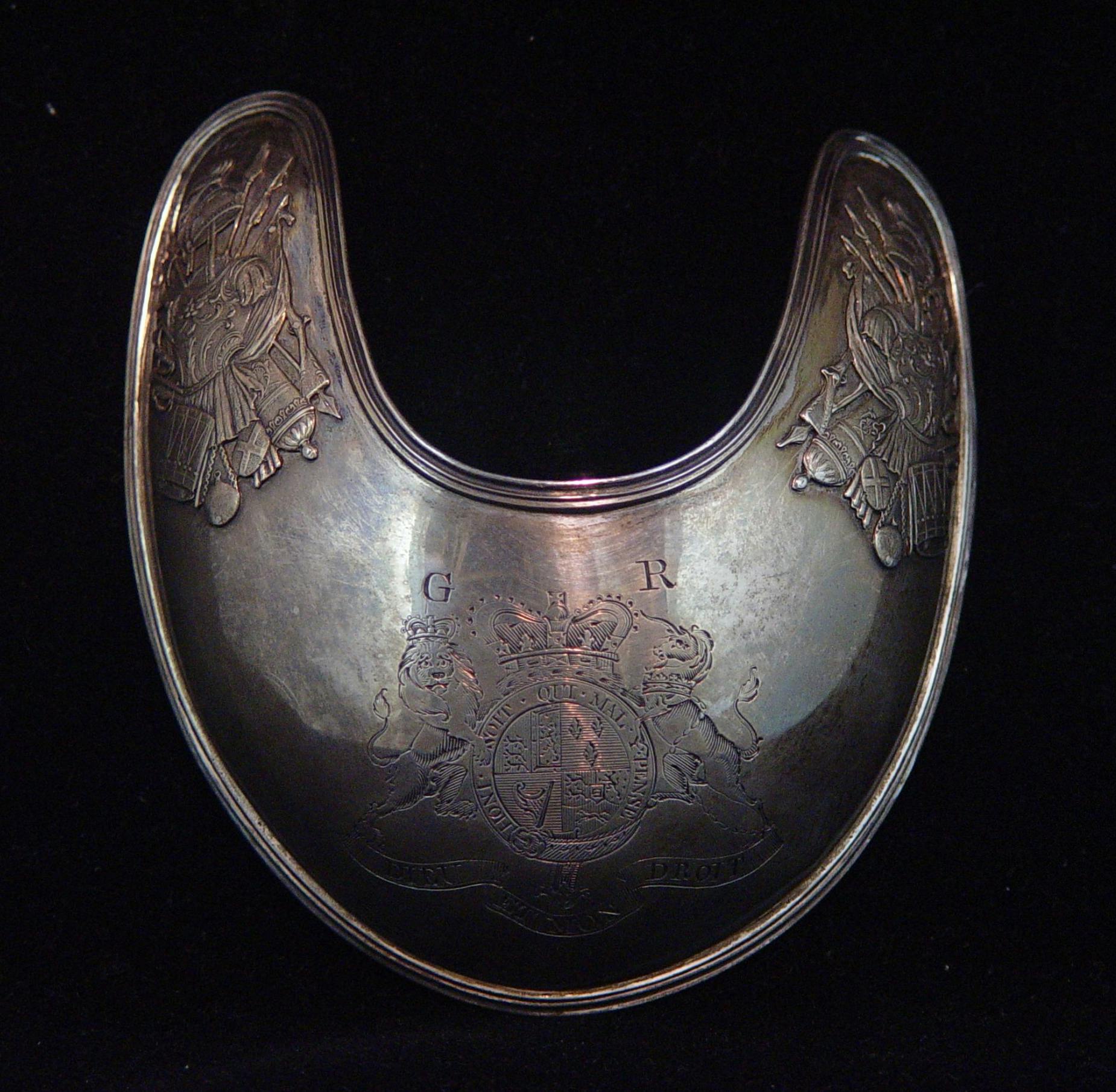
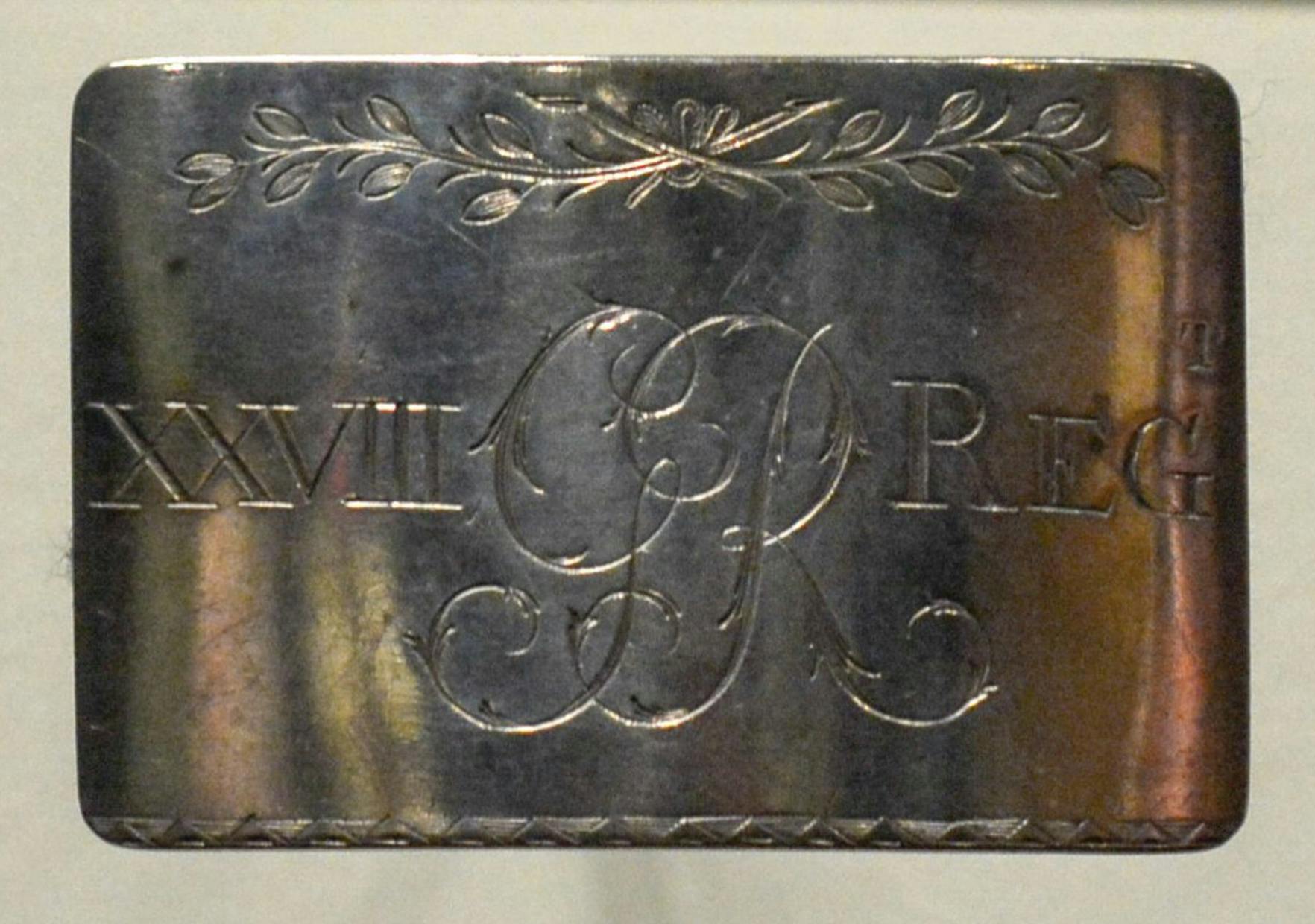
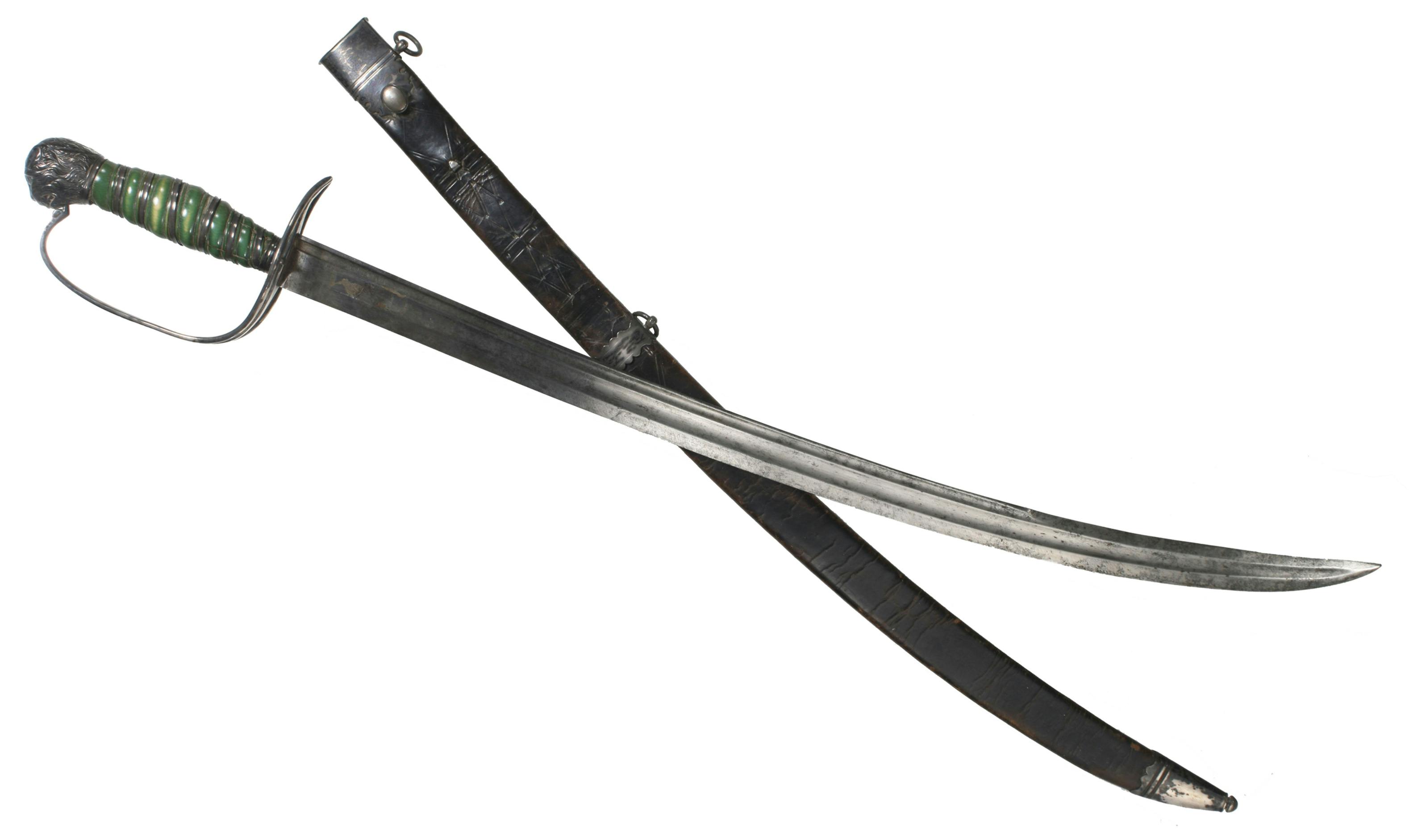
A Redcoat’s Uniform
Lieutenant Ely Dagworthy of the British 44th Regiment wore this uniform while serving in America a few years prior to the Revolutionary War. Decorated with extra silver trim, Dagworthy probably wore the coat for special occasions, rather than on campaign. The red coat Richard Mansergh St. George wears in his 1776 portrait has no silver trim. Stories spreading in Ireland and Great Britain about sharpshooting American riflemen picking off British officers encouraged some regimental commanders to have their officers wear less conspicuous uniforms in battle.
Coat
ca. 1768
Wool, Silver
Courtesy of Dumbarton House/The National Society of The Colonial Dames of America. Photograph by Mark Finkenstaedt.
A Redcoat’s Uniform
Lieutenant Ely Dagworthy of the British 44th Regiment wore this uniform while serving in America a few years prior to the Revolutionary War. Decorated with extra silver trim, Dagworthy probably wore the coat for special occasions, rather than on campaign. The red coat Richard Mansergh St. George wears in his 1776 portrait has no silver trim. Stories spreading in Ireland and Great Britain about sharpshooting American riflemen picking off British officers encouraged some regimental commanders to have their officers wear less conspicuous uniforms in battle.
Coat
ca. 1768
Wool, Silver
Courtesy of Dumbarton House/The National Society of The Colonial Dames of America. Photograph by Mark Finkenstaedt.
A Redcoat’s Uniform
Lieutenant Ely Dagworthy of the British 44th Regiment wore this uniform while serving in America a few years prior to the Revolutionary War. Decorated with extra silver trim, Dagworthy probably wore the coat for special occasions, rather than on campaign. The red coat Richard Mansergh St. George wears in his 1776 portrait has no silver trim. Stories spreading in Ireland and Great Britain about sharpshooting American riflemen picking off British officers encouraged some regimental commanders to have their officers wear less conspicuous uniforms in battle.
Coat
ca. 1768
Wool, Silver
Courtesy of Dumbarton House/The National Society of The Colonial Dames of America. Photograph by Mark Finkenstaedt.
A Redcoat’s Uniform
Lieutenant Ely Dagworthy of the British 44th Regiment wore this uniform while serving in America a few years prior to the Revolutionary War. Decorated with extra silver trim, Dagworthy probably wore the coat for special occasions, rather than on campaign. The red coat Richard Mansergh St. George wears in his 1776 portrait has no silver trim. Stories spreading in Ireland and Great Britain about sharpshooting American riflemen picking off British officers encouraged some regimental commanders to have their officers wear less conspicuous uniforms in battle.
Coat
ca. 1768
Wool, Silver
Courtesy of Dumbarton House/The National Society of The Colonial Dames of America. Photograph by Mark Finkenstaedt.
A Redcoat’s Uniform
Lieutenant Ely Dagworthy of the British 44th Regiment wore this uniform while serving in America a few years prior to the Revolutionary War. Decorated with extra silver trim, Dagworthy probably wore the coat for special occasions, rather than on campaign. The red coat Richard Mansergh St. George wears in his 1776 portrait has no silver trim. Stories spreading in Ireland and Great Britain about sharpshooting American riflemen picking off British officers encouraged some regimental commanders to have their officers wear less conspicuous uniforms in battle.
Coat
ca. 1768
Wool, Silver
Courtesy of Dumbarton House/The National Society of The Colonial Dames of America. Photograph by Mark Finkenstaedt.
A Redcoat’s Uniform
Lieutenant Ely Dagworthy of the British 44th Regiment wore this uniform while serving in America a few years prior to the Revolutionary War. Decorated with extra silver trim, Dagworthy probably wore the coat for special occasions, rather than on campaign. The red coat Richard Mansergh St. George wears in his 1776 portrait has no silver trim. Stories spreading in Ireland and Great Britain about sharpshooting American riflemen picking off British officers encouraged some regimental commanders to have their officers wear less conspicuous uniforms in battle.
Coat
ca. 1768
Wool, Silver
Courtesy of Dumbarton House/The National Society of The Colonial Dames of America. Photograph by Mark Finkenstaedt.
A Redcoat’s Uniform
Lieutenant Ely Dagworthy of the British 44th Regiment wore this uniform while serving in America a few years prior to the Revolutionary War. Decorated with extra silver trim, Dagworthy probably wore the coat for special occasions, rather than on campaign. The red coat Richard Mansergh St. George wears in his 1776 portrait has no silver trim. Stories spreading in Ireland and Great Britain about sharpshooting American riflemen picking off British officers encouraged some regimental commanders to have their officers wear less conspicuous uniforms in battle.
Coat
ca. 1768
Wool, Silver
Courtesy of Dumbarton House/The National Society of The Colonial Dames of America. Photograph by Mark Finkenstaedt.
Silk Officer’s Sash
Crimson silk sashes served as signs of rank for the officers who wore them around their waist, as St. George does in his portrait.
Sash
1770-1800
Silk
Museum of the American Revolution, Gift of Dr. and Mrs. James Stryker Studdiford
Fusil and Bayonet
British officers who served in America often carried fusils that they purchased. Compared to the muskets that enlisted soldiers carried, fusils are lighter in weight and more finely crafted. A fusil and bayonet provided an officer with a more practical weapon for fighting in wooded country against sharpshooting riflemen than a cumbersome spontoon (tall spear).
Fusil (firearm)
Lock made by John Clark
1765-1775
Iron, Steel, Brass, Wood
Museum of the American Revolution
Bayonet
1775-1800
Iron, Steel
Museum of the American Revolution
Engraved Gorget
An officer in the 60th Regiment wore this gorget featuring the coat of arms of King George III. Gorgets served as a sign of rank for an officer and illustrated that he fought in defense of the Crown. Gorgets descended from throat guards worn by medieval knights as part of their suits of armor. British Army regulations stated that the gorget, coat lace, hat trimmings, buttons, and belt plates worn by officers should match in color and material. Like the 60th Regiment, Richard Mansergh St. George’s 4th Regiment wore silver insignia.
Gorget
Made by Thomas Hall or Thomas Hallows
1775
Silver
Museum of the American Revolution
Silver Belt Plate
An officer in the 28th Regiment wore this silver belt plate to secure his leather sword belt. British Army regulations ordered that officers should wear belt plates engraved with the number or special insignia of their regiment. Compare this silver belt plate to the one depicted in St. George’s portrait. Can you find the Roman numeral “IV” engraving for the 4th Regiment in the portrait?
Belt Plate
1760-1783
Silver
Courtesy of New-York Historical Society, Gift of Captain Howland Pell, 1920
Officer’s Sword
Richard Mansergh St. George carried a silver-hilted hanger (a short sword) with a lion head, like this one, to America. The lion head is a symbol of power commonly found on British swords from the late 1700s. Officers carried swords to indicate their rank and for self-defense.
Hanger (sword) & Scabbard
Attributed to James Cullum
1760s
Steel, Iron, Silver, Ivory, Leather
Courtesy of Don Troiani